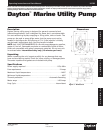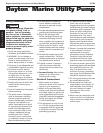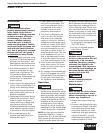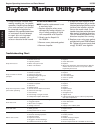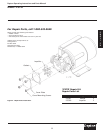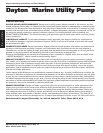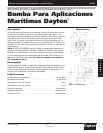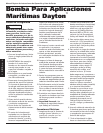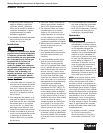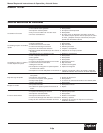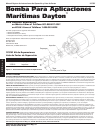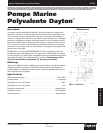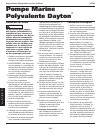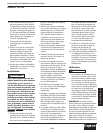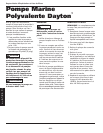
Dayton Operating Instructions and Parts Manual 1P579F
E
N
G
L
I
S
H
2
Safety Guidelines
Do not use to pump flammable
or explosive fluids such as
gasoline, fuel oil, kerosene,
etc. Do not use in flammable
and/or explosive atmospheres.
Pump should only be used with
liquids compatible with pump
component materials. Failure
to follow this warning can
result in personal injury and/or
property damage.
1. Know the pump application,
limitations, and potential hazards.
2. WARNING: Do not handle a
pump or pump motor with wet
hands or when standing on a
wet or damp surface, or in water.
3. The pump is not submersible and
is intended for open-air use only.
4. Disconnect power before
servicing a motor or its load.
If the power disconnect is out-
of-sight, lock it in the open
position and tag it to prevent
unexpected application of power.
5. Release all pressure within the
system before servicing any
component.
6. Drain all liquids from the system
before servicing.
7. The pump motor is equipped
with an automatic resetting
thermal protector and may
restart unexpectedly. Protector
tripping is an indication of
motor overloading as a result
of operating the pump at low
heads (low discharge restric-
tion), excessively high or low
voltage, inadequate wiring,
pumping too hot a liquid,
incorrect motor connections,
or a defective motor or pump.
Read troubleshooting chart.
WARNING
8. Do not touch an operating
motor. Modern motors are
designed to operate at high
temperatures.
9. Provide adequate protection and
guarding around moving parts.
10. Secure the discharge line
before starting the pump. An
unsecured discharge line will
whip, possibly causing personal
injury and/or property damage.
11. Check hoses for weak or worn
condition before each use, making
certain that all connections are
secure.
12. Periodically inspect pump and
system components. Perform
routine maintenance as required
(see Maintenance section).
13. Provide a means of pressure
relief for pumps whose dis-
charge line can be shut-off or
obstructed.
14. Personal Safety: Wear safety
glasses at all times when
working with pumps.
Electrical Connections
1. Make certain that power
source conforms to the require-
ments of your equipment.
2. When wiring an electrically
driven pump, follow all electrical
and safety codes, as well as the
most recent National Electrical
Code (NEC) and the Occupational
Safety and Health Act (OSHA)
in the United States.
3. This equipment is only for use
on 115 volt (single-phase) and
is equipped with an approved
3-conductor cord and 3-prong,
grounding-type plug.
4. To reduce the risk of electric
shock, the unit should be
plugged directly into a properly
installed and grounded 3-prong
grounding-type receptacle. The
green (or green and yellow)
conductor in the cord is the
grounding wire. The motor
must be securely and adequately
grounded for your protection
against shock hazards! Never
connect the green (or green and
yellow) wire to a live terminal!
5. Where a 2-prong wall receptacle
is encountered, it must be
replaced with a properly
grounded 3-prong receptacle
installed in accordance with
the National Electrical Code
and local codes and ordinances.
6. To ensure a proper ground, the
grounding means must be tested
by a qualified electrician. Use
only 3-wire extension cords
that have 3-prong, grounding-
type plugs and receptacles that
accept the equipment plug.
7. All wiring should be performed
by a qualified electrician.
8. Protect electrical cord from
sharp objects, hot surfaces, oil
and chemicals. Avoid kinking
the cord. Replace or repair
damaged or worn cords
immediately.
9. When using an extension cord,
make sure wire is of adequate
size to minimize voltage drop
at the motor.
Dayton
™
Marine Utility Pump



